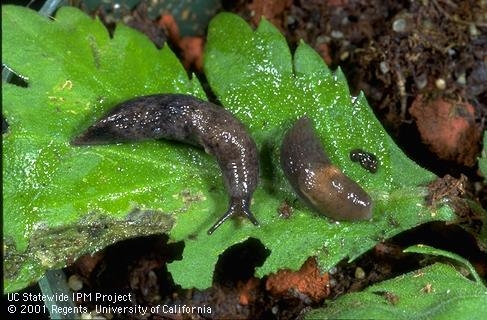By Brent McGhie, Butte Coounty Master Gardener, April 21, 2017.

To control snails, slugs and other pests, the University of California recommends that homeowners follow the Integrated Pest Management (IPM) process. IPM is a strategy that focuses on long-term prevention of pests by utilizing cultural, biological, mechanical and physical controls. With IPM, pesticides (chemical control) are used only as a last resort, and when pesticides are used, they are applied in ways that minimize harm to nontarget organisms, humans, pets, and the environment.
Cultural controls involve manipulating the environment to make an area less hospitable for a pest. In the case of snails and slugs, a good first step is to eliminate places they can hide during the day. Such hiding places include boards, stones, debris, weedy areas around tree trunks, leafy branches close to the ground and dense ground covers. If hiding places can't be eliminated, vegetable gardens and susceptible plants should be located as far from them as possible. Switching from sprinklers or flood irrigation to drip irrigation will also make the habitat less desirable for snails and slugs by reducing the humidity and moist surfaces they prefer.

Mechanical or physical controls kill a pest directly or block a pest from an area experiencing damage. In the case of snails and slugs, handpicking is an effective mechanical control if it is done on a regular basis. They can be searched out after dark with a flashlight and then either crushed in place or picked up with rubber gloves. Once they have been picked up, they can be placed in a bag and thrown away in the trash, or placed in a bucket of soapy water and disposed of in a compost pile after they are dead. Alternatively, if you are lucky enough to know someone with pet turtles, you can give your snails and slugs to them (as long as they are healthy) -- most turtle owners are happy to receive these pests, which add protein to the turtle diet. Those with backyard chickens may be similarly appreciative, as chickens, too, eat snails.
Another method of mechanical control is trapping. Traps don't have to be elaborate. Boards, flower pots and even melon rinds scattered throughout the garden will attract snails and slugs and then it is just a matter of scraping off the accumulated pests and destroying them every day or so, using the methods described above. Do not use salt to kill slugs and snails because is harmful to the soil. Another type of trap consists of a can or jar buried in the ground and baited with beer or a sugar-water yeast mixture. Because the liquid in these traps must be replenished every few days, and will only attract slugs and snails from an area within a few feet, they are not considered to be particularly effective.
Copper flashing or copper foil can be used as a physical barrier for slugs and snails. It is believed that copper is an effective barrier because it reacts with the slime of these pests, causing a disruption in their nervous system that is similar to an electric shock. These barriers should be at least four inches wide with the bottom buried in the soil to prevent slugs from crawling under them. Dry ashes or other abrasives such as diatomaceous earth can also be used as barriers for slugs and snails. Such abrasives should be piled about one inch high and 3 inches wide to be effective. However, these materials lose their deterrent value if they become damp, making them not very useful in most garden situations. Another drawback of wood ashes is that they are quite alkaline and can have a detrimental effect on soil pH.
Biological control involves using natural enemies to control pest populations. Snails and slugs have many natural enemies, but these beneficials are rarely effective enough to provide satisfactory control in the garden. Domestic fowl such as chickens, ducks, or geese can be effective snail predators, but will also eat seedlings and should be employed with this in mind.
Slug and snail baits can be applied as a last resort, but are most effective if used in conjunction with the IPM methods described above. There are other effective baits, but baits containing iron phosphate are the only ones that are safe for children, domestic animals, birds, fish and other wildlife. Iron phosphate baits are sold under many trade names including Sluggo and Escar-Go. The bait should be placed in moist areas that snails or slugs are likely to frequent. Timing is also important. If the weather is very hot, dry, or cold, baiting will have a limited effectiveness because slugs and snails are least active during these times. Take advantage of snail and slug habits by irrigating before baiting and scattering the bait in the late afternoon or evening.
For more information, consult:
http://ipm.ucanr.edu/PMG/PESTNOTES/pn7427.html
http://www2.ipm.ucanr.edu/WhatIsIPM/
http://ipm.ucanr.edu/PMG/H/I-SM-HASP-AD.017.html